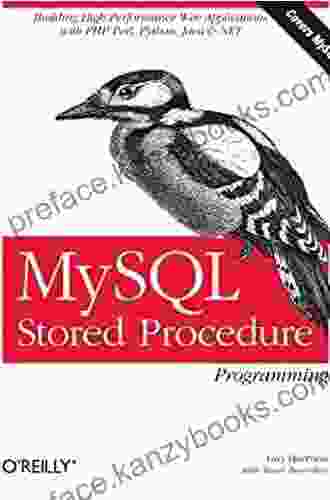Build High-Performance Web Applications in MySQL: The Ultimate Guide

In today's competitive digital landscape, the performance of your web application can make or break your success. Slow-loading websites and applications can lead to frustrated users, high bounce rates, and lost conversions. MySQL is a powerful and widely-used database management system (DBMS) that underpins many high-traffic web applications. However, optimizing MySQL for maximum performance and scalability requires a deep understanding of its architecture, indexing techniques, and configuration options.
This comprehensive guide will provide you with the knowledge and tools necessary to build high-performance web applications using MySQL. We will cover database design best practices, query optimization techniques, and server configuration strategies to help you achieve optimal application speed and scalability.
4.4 out of 5
| Language | : | English |
| File size | : | 14894 KB |
| Text-to-Speech | : | Enabled |
| Screen Reader | : | Supported |
| Enhanced typesetting | : | Enabled |
| Print length | : | 944 pages |
Database Design for High Performance
The design of your database schema has a significant impact on its performance. Poorly designed schemas can lead to inefficient queries, slow data retrieval, and data inconsistencies. Here are some key principles to follow when designing your MySQL database for high performance:
- Normalize your data: Data normalization involves organizing your data into tables based on its logical relationships. By eliminating data redundancy and creating relationships between tables, you can improve query performance and reduce data inconsistencies.
- Use the appropriate data types: Choosing the right data type for each column is crucial for efficient storage and performance. For example, use integer data types for numeric values and VARCHAR or TEXT data types for strings.
- Index your tables: Indexes are data structures that help MySQL quickly find data in your tables. Proper indexing can significantly improve query performance, especially for large tables.
- Minimize table joins: Joins are used to combine data from multiple tables. While joins are sometimes necessary, they can Slow down your queries. Avoid using unnecessary joins and consider using subqueries or views to optimize performance.
Query Optimization Techniques
Once your database is designed for performance, you need to optimize your queries to retrieve data efficiently. Here are some effective query optimization techniques to consider:
- Use EXPLAIN to analyze queries: The EXPLAIN command provides valuable insights into how MySQL processes your queries. It shows the query execution plan, including the indexes used, join Free Download, and estimated execution time.
- Optimize your WHERE clauses: The WHERE clause is used to filter data from your tables. Use indexes on the columns used in the WHERE clause to improve query performance.
- Limit the number of results: If you only need a subset of data, use the LIMIT clause to limit the number of results returned by your query.
- Use caching strategies: Caching involves storing frequently accessed data in memory to reduce the number of database queries. MySQL provides several caching mechanisms, such as query caching and table buffering.
Server Configuration for Performance
In addition to database design and query optimization, the configuration of your MySQL server can also impact performance. Here are some key server configuration parameters to consider:
- innodb_buffer_pool_size: This parameter controls the size of the buffer pool, which is used to cache frequently accessed data. A larger buffer pool can improve performance for read-intensive applications.
- innodb_flush_log_at_trx_commit: This parameter specifies when MySQL should write changes to the redo log. Setting it to 2 can improve performance for write-intensive applications.
- max_connections: This parameter controls the maximum number of simultaneous connections to the MySQL server. Adjust this parameter based on the expected load on your application.
- query_cache_size: This parameter controls the size of the query cache, which stores recently executed queries and their results. A larger query cache can improve performance for frequently executed queries.
Monitoring and Performance Tuning
Once your MySQL application is up and running, it's essential to monitor its performance and make adjustments as needed. Here are some key performance metrics to monitor:
- Query execution time: Use tools like MySQL's slow query log to identify queries that are taking too long to execute.
- Database load: Monitor the CPU and memory usage of your MySQL server to ensure that it has sufficient resources to handle the load.
- Connection count: Monitor the number of active connections to your MySQL server to identify potential bottlenecks.
Based on the performance metrics, you can fine-tune your database design, query optimization, and server configuration to improve application performance. Performance tuning is an ongoing process that requires regular monitoring and adjustments to ensure optimal performance.
By following the principles outlined in this guide, you can build high-performance web applications that can handle even the most demanding workloads. By optimizing your database design, using effective query optimization techniques, and configuring your MySQL server for performance, you can achieve optimal application speed and scalability. Remember to monitor your application's performance and make adjustments as needed to maintain high performance over time.
With the knowledge and tools provided in this guide, you can unlock the full potential of MySQL and build web applications that deliver exceptional user experiences.
4.4 out of 5
| Language | : | English |
| File size | : | 14894 KB |
| Text-to-Speech | : | Enabled |
| Screen Reader | : | Supported |
| Enhanced typesetting | : | Enabled |
| Print length | : | 944 pages |
Do you want to contribute by writing guest posts on this blog?
Please contact us and send us a resume of previous articles that you have written.
 Book
Book Novel
Novel Page
Page Chapter
Chapter Text
Text Story
Story Genre
Genre Reader
Reader Library
Library Paperback
Paperback E-book
E-book Magazine
Magazine Newspaper
Newspaper Paragraph
Paragraph Sentence
Sentence Bookmark
Bookmark Shelf
Shelf Glossary
Glossary Bibliography
Bibliography Foreword
Foreword Preface
Preface Synopsis
Synopsis Annotation
Annotation Footnote
Footnote Manuscript
Manuscript Scroll
Scroll Codex
Codex Tome
Tome Bestseller
Bestseller Classics
Classics Library card
Library card Narrative
Narrative Biography
Biography Autobiography
Autobiography Memoir
Memoir Reference
Reference Encyclopedia
Encyclopedia John Strickland
John Strickland Joshua Kozak
Joshua Kozak Hape Kerkeling
Hape Kerkeling Jon Bonnell
Jon Bonnell Paulene Christie
Paulene Christie Regina Duke
Regina Duke Hannah Abedi
Hannah Abedi Jeff Geller
Jeff Geller Johnny Mudd
Johnny Mudd Gregory Keys
Gregory Keys James A Hall
James A Hall Martin Meyer
Martin Meyer Mike Angarola
Mike Angarola Stephanie Thomas
Stephanie Thomas Horatio Alger
Horatio Alger Gregg Avedon
Gregg Avedon Hannah Miller
Hannah Miller Natasha Brown
Natasha Brown Ray Kurzweil
Ray Kurzweil Hannie P Scott
Hannie P Scott
Light bulbAdvertise smarter! Our strategic ad space ensures maximum exposure. Reserve your spot today!

 Jimmy ButlerDiscover the Secrets to Thrive in the Wild: "Natural History Treatment and...
Jimmy ButlerDiscover the Secrets to Thrive in the Wild: "Natural History Treatment and... Felix CarterFollow ·11k
Felix CarterFollow ·11k Mark TwainFollow ·17.1k
Mark TwainFollow ·17.1k Evan HayesFollow ·8.9k
Evan HayesFollow ·8.9k Graham BlairFollow ·12.9k
Graham BlairFollow ·12.9k Jaylen MitchellFollow ·17.8k
Jaylen MitchellFollow ·17.8k Julio Ramón RibeyroFollow ·14.2k
Julio Ramón RibeyroFollow ·14.2k Harvey HughesFollow ·4.5k
Harvey HughesFollow ·4.5k Owen SimmonsFollow ·19.5k
Owen SimmonsFollow ·19.5k

 Julian Powell
Julian PowellUnleash Your Inner Adonis: The Ultimate Guide to...
Are you ready to...

 Josh Carter
Josh CarterJourney into Enchanting Tales: Tales From The Brothers...
Discover a Literary...

 Robbie Carter
Robbie CarterUnlock Your Culinary Potential: The Best Guide for...
Embark on a culinary adventure with The...

 Colby Cox
Colby CoxUnlock Culinary Delights: 25 Effortless Vegetable Side...
Are you ready to embark on a culinary...

 Joseph Foster
Joseph FosterHow to Plan the Perfect Party: A Comprehensive Guide to...
Are you tired of throwing the...
4.4 out of 5
| Language | : | English |
| File size | : | 14894 KB |
| Text-to-Speech | : | Enabled |
| Screen Reader | : | Supported |
| Enhanced typesetting | : | Enabled |
| Print length | : | 944 pages |












